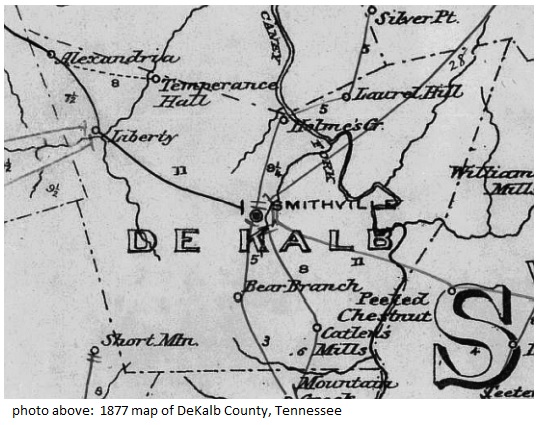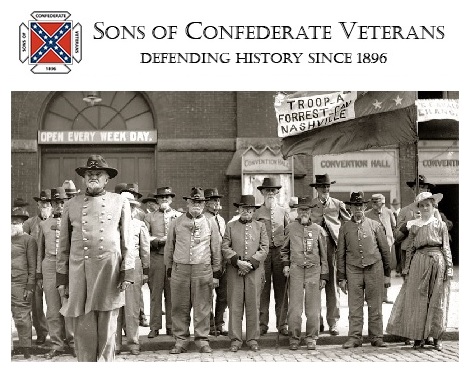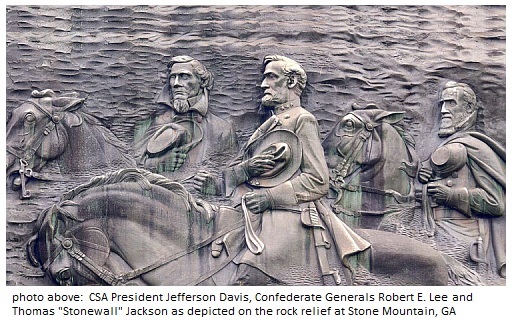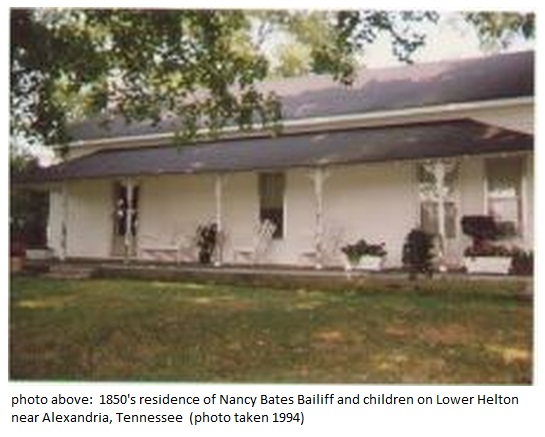Articles
2001 Bailiff Reunion
Bailiff Reunion held at Fall Creek Falls near Pikeville, TN
2004 Barrett Reunion
Barrett Reunion held at Liberty, TN
2013 Possum Hollow Community Reunion
Possum Hollow Community Reunion held at Dry Creek Baptist Church, Dowelltown, TN
A Glimpse of Our Past
Monroe Bailiff in Battle of Chickamauga and early days in Possum Hollow community
Adventures of Charles Beverly Hughes in California
Camping trip with Bert Orin Bailiff
A. J. Bailiff recalls Civil War experiences
Adolphus Judson Bailiff recalls dates and incidents with unusual accuracy
Alsia Chapman Bailiff
Mrs. T.C. Bailiff freezes to death in Colorade blizzard
Allison's Tennessee Cavalry Squadron (Confederate)
Squadron Roster
Bailiff family of DeKalb County
A Brief Summary
Bailiff Roots in Scotland and Thomas Bailiff documented in PA and NC
Thos. Bayliff is taxed in West Bradford, Chester County, Pa.
Bailiiff Saw Mill & Ferry
Bailiff Saw Mill at mouth of Barren Creek where Webb School Camp later established
Battle of Snow Hill (PDF)
Correspondent report from DeKalb Co, TN as reported in "New York Times", 1863
Claude Alverson Bailiff
90 years old, but active grandparent
Columbus Allen Bailiff
Buried Alexandria Eastview Cemetery
Communities of DeKalb County (PDF)
Short Histories of Dry Creek and Snow Hill
Daniel J. Bayliff
Instant Death - Struck by Big Four Train
Dry Creek Bridge
Bridge to be Closed to Traffic but Preserved as Historical Structure
Dry Creek Baptist Church Centennial 1989
James Monroe Bailiff ordained deacon 1891
Edgar Bailiff
He saw the hearse coming for him
Fred and Ivy Bailiff Pidgeon Honeymoon
Married at San Francisco
Forrest Lee Bailiff Killed
Collin Co, TX "Democrat" and the "Dallas Morning News"
Garland Bailiff
How We Went 'Round & 'Round in the West and Came Out Here
George Bailiff
No Horse was too Tough for Cabazon Pioneer - Nor was Modern Machinery
Gid Talley Bailiff
DeKalb Quarry Superintendent Hurled 12 feet by Mystery Explosion
Imogene Barrett Hays
Sending last telegraph message from Clarksville, TN Western Union Office
Ivy Bailiff Pidgeon (PDF)
The Story of her Life
Jewel Jones Letters (PDF)
Letters written to Jewel Jones from her mother, Callie Adcock
J.M. Bailiff
A local soldier's story
J.M. Bailiff Farm
The Early Years
Joe Bailiff (JS)
Life on Beech Mountain
John Bailiff and son of Sonoma, California
A Brief Biography
Kristen Leigh Bayliff Wedding Announcement
United in Marriage at Shiloh United Methodist Church
Life on Dry Creek
James Monroe Bailiff, a Civil War soldier
Lower Oxford Company (Revolutionary War)
Muster Rolls and Papers Relating to the Associators and Militia of the County of Chester
Marker of Frankie Bailiff returned to Santa Rosa Rural Cemetery
He recently cleaned out a tool shed and found the headstone of little Frankie Bailiff
Nellie Bailiff
Letter from H.H. West
Nellie Bailiff Memorial
1864-1953
News from 1890's DeKalb County
The "Liberty Herald" and "Alexandria Times" Newspapers
Remembering Paul Robinson
When Paul and Amy left the mission field, they returned to Smithville near Paul’s birthplace
Reba Bailiff and Ralph Hunter Wedding Announcement
Pretty Wedding at the Home of Mr. and Mrs. E.G. Bailiff
Robert Bailiff, formerly of Illinois
This Man is Homesick
Testimony of Paul Robinson
Missionary to Uruguay
Thomas Bailiff
Post Master of Cherry, Illnois and Miner - 1909 Mine Disaster
William Bain's Pension Application and David C. Bain's Resignation
A native of White County, Tennessee

Family Tree Files
- The Bailiff and Related Families
hosted on Bailifffamily.com - The Bailiff and Related Families
hosted on Tribalpages.com
Same information on both sites. Slightly different formats. Anyone born within the last one hundred years is assumed to be living, unless otherwise noted, and detailed personal information is withheld.
A password is not required to view the information contained in the family tree files.

Notes & Transcriptions by Ron Cornwell
The Bailiff family (PDF)
Documentation of the Bailiff families of Illinois, N. Carolina, Pennsylvania, and Tennessee

Obituaries
Death records from newspapers and other sources


Bailiff Family Crest
Some records suggest that the surname Bayliff was first found in Glamorganshire, a region of South Wales, anciently part of the Welsh kingdom of Glywysing, where they held a family seat from very ancient times, long before the Norman Conquest in 1066.
Other records tell us that the name was derived from the Old French "baillis" and was brought into England and Scotland from Normandy, during the wake of the Norman Conquest of 1066.

Where were my Bailiff's from?
Although Bailiffs have settled in many areas throughout the United States, my direct line of descent settled in the Temperance Hall community, just east of Alexandria, in what is now DeKalb County, Tennessee. They came to DeKalb County from Orange County, North Carolina during the 1820's.
My direct ancestor, Thomas Bailiff, settled in Orange County, North Carolina during the 1760's. He served as a juryman there in 1765. His family was from Chester County, Pennsylvania. The Bayliff families there were shown on tax lists from the 1740's through the 1760's.
Other known areas of settlement by Bailiff (Bayliff) families during the 1800's are Alabama, Arkansas, California, Illinois, Indiana, Iowa, Louisiana, Michigan, Ohio, and Texas.

map courtesy of The University of Alabama

Defend Your Heritage - The Sons of Confederate Veterans


Who are the SCV?
The SCV is the direct heir of the United Confederate Veterans, and the oldest hereditary organization for male descendants of Confederate soldiers. Organized at Richmond, Virginia in 1896, the SCV continues to serve as a historical, patriotic, and non-political organization dedicated to ensuring that a true history of the 1861-1865 period is preserved.
We, the Sons of Confederate Veterans, having been commissioned by the Confederate Veterans themselves, retain our responsibility and right to adhere to the founding principles of the United States of America remembering the bravery, defending the honor and protecting the memory of our beloved Confederate Veterans, which includes their memorials, images, symbols, monuments and grave sites for ourselves and future generations.
Membership in the Sons of Confederate Veterans is open to all male descendants of any veteran who served honorably in the Confederate armed forces.
Charge to the Sons of Confederate Veterans
To you, Sons of Confederate Veterans, we will commit the vindication of the cause for which we fought. To your strength will be given the defense of the Confederate soldier’s good name, the guardianship of his history, the emulation of his virtues, the perpetuation of those principles which he loved and which you love also, and those ideals which made him glorious and which you also cherish.
Lt. General Stephen Dill Lee, Commander General, United Confederate Veterans, New Orleans, Louisiana, April 25, 1906
Links to the Sons of Confederate Veterans and to an SCV membership application can be found on our Links page.


Supporting Confederate Memorials
Why support Confederate memorials? For the love of family.
My grandfather was born in 1911 and lived almost his entire life in the Possum Hollow community of Dry Creek. He lived in the house that his parents built in 1923. Their home was only a few minutes walk from the doorstep of his grandparent's home on the same farm.
My grandfather's grandparents bought the farm in 1875 and made their home there. They had nine children of which my great grandfather was next to the youngest being born in 1884.
My grandfather's grandfather was born in 1845 in the Temperance Hall community of what was then Smith County. His father died in 1852. He made provisions for the family to move to Alexandria upon his death. And so they did.
War broke out in 1861. My grandfather's grandfather and his three brothers answered the call to arms to defend their home state of Tennessee.
Now, why would a person take up arms against the United States government in defense of a state? To understand properly, one must reason as a person living in Tennessee in 1861, not as a person living today. In 1861, one's loyalty lay with where you lived, Tennessee.
Before the War Between the States, the states were sovereign entities that agreed to come together to form a union. And, each sovereign state held the belief that they could leave this union at any time.
Most documents of the nineteenth century state that the United States ARE (plural) versus the United States IS (singular). After the war, the U.S. became an IS (centralized, taking power away from the states) courtesy of Mr. Lincoln.
One of the brothers was shot through the neck at Gettysburg and lingered for several days before dying. The family to this day doesn't know where he is buried or even if he was buried at all. This brother died leaving behind a wife and children. He has several descendents still living in DeKalb County today.
My grandfather's grandfather was himself shot at the battle of Chickamauga, Georgia in 1863. He and his older brother were captured and sent to prison in Louisville, Kentucky. His brother had typhoid and almost died. He eventually survived the typhoid and lived out his days in Alexandria marrying and raising a family.
The other remaining brother also survived the war, but with hearing loss from exploding cannon. He moved from DeKalb County to Texas and raised his family there.
My grandfather's grandfather died from cancer in 1927.
I remember his log home being on the north side of our farm when I was a small child. The old spring house is still there.
I remember many stories that my grandfather told me about his grandfather.
He was excited to tell his wife about sitting in a horseless carriage (a car) on Snow Hill. Wouldn't let the owner start the engine as he was scared of it running away with him.
When he first moved to Possum Hollow, he used oxen to clear the farm. He purchased mules years later. I still have one of his oxen yoke.
He was a skilled blacksmith and kept an old gourd hanging from a nail in the spring house so that he could drink it's cool water.
He kept his shotgun hanging over the front door and allowed my grandfather to use it to hunt.
My grandfather told that he could remember sitting in his grandfather's lap as a young boy and feeling the bulge of the bullet left in his side from the old wound at the battle of Chickamauga. The bullet was never removed.
When I see these Confederate memorials being spray painted and violently torn from their bases, it is as if someone were walking through a cemetery and turning over gravestones with no remorse. An absolute act of evil.
And politicians stating that anything identified as Confederate is representative of hate and racism is nothing but ignorance and lies.
Hate is when the media broadcasts that being Confederate is equivalent to being a member of the KKK and other extremist, hate groups.
Hate is when someone calls you a Nazi and a white supremacist because you descend from a Confederate veteran and refuse to deny your heritage.
Hate is when you aren't allowed to publicly honor your ancestors, your family.
written by Kevin Bandy


1850's Bailiff Homeplace on Lower Helton
Thomas Isaac Bailiff was a member of the Masonic Lodge at Temperance Hall. He died in 1852; two years before his father, Thomas Bailiff, Jr. He instructed in his will that his wife, Nancy, with the assistance of members of the Masonic Lodge to sell the farm at Temperance Hall and buy a farm nearer to Alexandria to raise the children. The farm was on Lower Helton and the house still stands where they lived. I visited in 1994 with Ms. Lucille Hale who resided there at the time.
Nancy moved from Temperance Hall with the younger children, Joab, William Rufus, James Monroe, and Roxanna. The residence was originally a log structure with a "dog-trot" separating the kitchen from the rest of the home. Siding was placed over the logs in later years. The date of 1856 can be faintly read on one of the chimney stones at the old kitchen.

Additional photographs and documents relating to genealogy can be found in Photos & Videos

